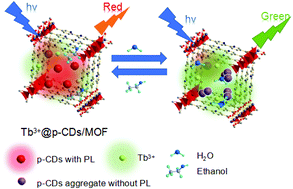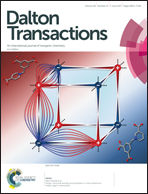A dual-emission probe to detect moisture and water in organic solvents based on green-Tb3+ post-coordinated metal–organic frameworks with red carbon dots†
Abstract
Using p-phenylenediamine as a precursor, p-carbon dots (p-CDs) with strong red-light emission were encapsulated into a metal–organic framework (MOF) followed by introduction of green light-emitting Tb3+ to form a two-color light-emitting hybrid (Tb3+@p-CDs/MOF). The as-prepared fluorescent-functionalized MOF not only maintained the excellent optical properties of p-CDs and Tb3+ to give strong emission, but also had good chemical and physical properties. The chosen p-CDs were aggregated readily in water, which led to only very weak photoluminescence, whereas the opposite effect was noted in the organic solvents ethanol, dimethylformamide and cyclopropane. Therefore, the as-prepared hybrid showed different color light emission in water or organic solvents, and acted as a ratiometric and colorimetric fluorescent probe to detect water content in organic solvents. Moreover, this hybrid also served as a ratiometric luminescent sensor for detection of relative humidity (RH): the ratio of light intensity at 545 nm to that at 605 nm increased linearly with increasing RH from 33.0% to 85.1% in the atmosphere.



 Please wait while we load your content...
Please wait while we load your content...